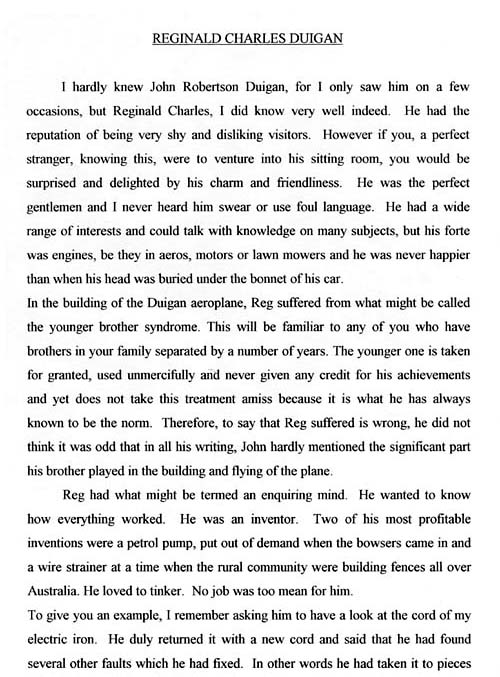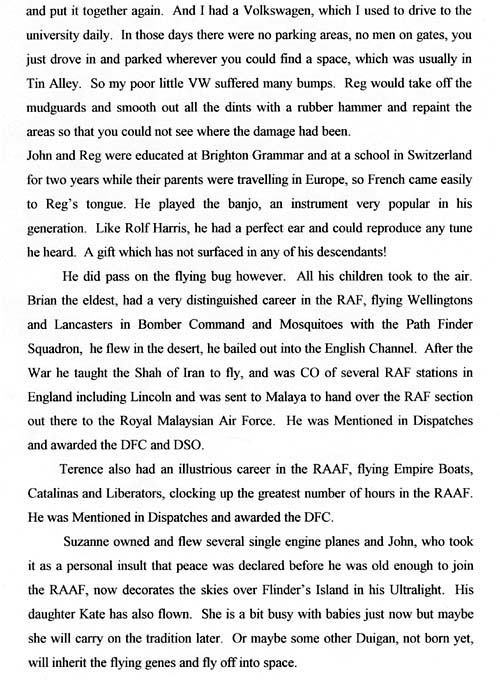
"I am honoured to be here today to celebrate the very excellent Duigan-Lewis exhibit. My only contribution is that I knew my father Reg very well. Uncle Jack and Ron Lewis, unfortunatley not well enough.
Uncle Jack was a smallish man - a great attribute if you were an early aviator! Dad was always very keen on sport and said Uncle Jack was a very good runner. And at a Bendigo athletics meeting he was persuaded by a large Irish policeman that a glass of port before the race would improve his action - Uncle Jack ran off the track and was disqualified.
The Charles Duigan children (2 boys & 3 girls) were lucky in that their mother was an excellent wood carver, and their father a successful trader in large station properties. The combination of a mother's workshop, overseas travel and education, and some spare cash proved an ideal breeding ground for invention and manufacture.
Dad and Uncle Jack eventually settled down to work a 14,000 acre property (Spring Plains) near Redesdale in Victoria. By this time Uncle Jack had scored a degree in Electrical Engineering whilst in England. Dad (7 years younger) spoke fluent French as he had just finished 2 years at school in Lucerne in Switzerland.
The year is now about 1908 and unless I'm very quick I'm going to exceed my 4 minute time limit! Spring Plains, a station workshop and Smithy, and by now a well defined ambition on the part of the brothers to build first a glider and then an aeroplane. According to Dad, the glider was not a great success. Designed to be tethered by fencing wire in a strong wind, the pilot was supposed to learn control in strong winds - frail gliders! No thank you!
Undaunted, work on the Uncle Jack designed aeroplane moved ahead quickly, assisted by my father, although he now had full time management responsibilities for 30,000 sheep. In less than one year building time the aeroplane made its first successfully controlled flight on October, 7th, 1910.
Unfortunately Uncle Jack had no offspring. However, my father had four, and to some extent we have all maintained the flying tradition.
* My late eldest brother Brian: RAF Wing Commander, DFC & bar, DSO - 3 tours over Europe in Wellingtons and Lancasters. Shot down by Vichi French fighters in the Saraha. Died in Woodend, Victoria in 1972.
* Terry. RAAF F/O. DFC Empire boats, Catalinas and Liberators. Unfortunately he is too ill to attend today, but most fortunate however, to be married to Dr Gwynne Duigan, who is here to carry to flag. see Gwynne's address
* My late sister, Sue: Probably the most extraordinary pilot since Uncle Jack. Sue spent a lot of time between Melbourne University and CSIRO. She did her PHD at Cambridge. At the age of 36 she decided to learn how to drive, having mastered a few hot Jaguars etc., she next took up flying. A few years before she died in 1993, she owned her own Piper 140 and used to visit us on Flinders Island in mid Bass Strait on a fairly regular basis.
* Finally me, 'the Baby': Whilst at school I always thought I would follow my brothers into the airforce. Not to be, the war ended just after my 18th birthday. The country was crowded with returning pilots. Instead I went to sea for six years, but not before learning to fly Tiger Moths off the Barwon Common in Geelong. For the last ten years I have had my own ultralight and use it for going around the farm and doing 'lolly drops' for kids.
Now for a different track - Ron and Mavis Lewis.
I met Ron in Heathcote when he was about half way through building the replica and again at Mangalore when it was complete except for the engine. Sister Sue and I spent a long time trying to convince Ron that we both had first claim to fly Ron's replica. Ron settled the argument by saying, in no uncertain terms, he built it, therefore HE would fly it first.
His attention to the detail of the airframe is immaculate, however ther are two major differences to the original. One, for obvious reasons, is the engine. Ron opted for a Volkswagen engine, about double the horsepower of the original engine designed and built in Melbourne by the engineering firm J.E. Tilley. Second, the flying controls. Ron opted for the conventional stick and rudder pedals, but the original had a stirrup to operate the rudder, Ailerons, by horizontal movement of the right hand stick and pitch, by a stick in the left hand.
To say the least - a clumsy system. Dad always said he wasn't sure why it turned out that way. But that's how it was. Ron said after he had flown his replica he was going to change the controls to the original configuration. Sadly his death intervened on both counts.
A brief mention of two people who lately have done a great deal of research on Duigan Aviation - Prof John Bird and Dr Russell Naughton...........thank you both for your tireless efforts in piecing the story together.
May I close by thanking the staff of this magnificent museum for honouring both the Duigan and Lewis families via the displayed aeroplane and for this afternoon tea to celebrate the occasion."
| 

